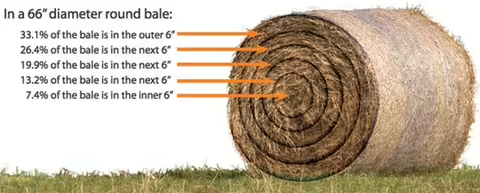
Hay Storage
Hay Storage Tips
Hay is the foundation of feeding livestock in periods of forage dormancy. The majority of hay is packaged in the form of a big round bale. Low labor requirement and little need for feeding infrastructure makes round baling attractive. One of the largest downfalls to big round bales is the weathering that occurs when the bales are stored outside.
The round shape of the bale results in a large surface area for weathering to occur. The figure below illustrates that 1/3 of the entire bale resides in the outer 6” of a 5.5 foot bale.
Typical storage loss of round bales in different storage methods*
- Shed: 5% dry matter loss
- Plastic wrap on ground: 5% dry matter loss
- Tarp on pad: 7% dry matter loss
- Bale sleeve on ground: 8% dry matter loss
- Elevated stack on ground: 10% dry matter loss
- Net wrap on ground: 23% dry matter loss
*Collins et al. , Round Bale Hay Storage in Kentucky
Storing Hay Inside
Storing hay inside a well ventilated barn will result in the least amount of loss. Humid regions, like Illinois, are good candidates for inside bale storage. Humid areas are also prone to bales being too wet at time of harvest. Bales too high in moisture can combust and catch fire. Thus, tightly packing bales into a barn can end with the loss of the shed if a bale catches fire.
When storing bales inside, consider these factors:
- Strictly monitor bale moisture. Bales with moisture over 20% have risk of heating and combusting. Bales may need monitored for temperature for up to 30 days. Temperatures of under 120°F degrees after this period are safe. Bales over 170°F pose serious danger of combusting. Bale temperature usually peaks 7 to 10 days post-baling.
- Stack bales to allow access to hay in the order it will be fed. For instance, first cutting is many times poorer quality. This hay would generally best match spring calving cow requirements early in the hay feeding season, where high quality hay would be better for lactating cows.
- Allow room for ventilation. Do not stack bales up against side walls. Allow some gaps in the stack for large lots of hay. Leave at least two feet of room between the bales and the rafters. Consider a covered ridge vent on your storage structure for better ventilation.
Storing Hay Outside
Outside storage of round bales can result in substantial losses of nutrient value and palatability of the hay. In turn, this leads to more shrink during storage and waste during feeding. Deterioration and feeding losses will greatly increase the cost of hay. If hay is stored outside and fed with an open ring feeder, it is not uncommon for waste/loss to be over 30%. Costs of increasing waste percentages are illustrated in table 2.
| Cost of Hay Consumed as Affected by Storage and Feeding Losses | ||||
| Beginning Hay Value, $ton | ||||
| % loss | 70 | 100 | 130 | 160 |
| 5 | $74 | $105 | $137 | $168 |
| 10 | $77 | $110 | $143 | $176 |
| 15 | $81 | $115 | $150 | $184 |
| 20 | $86 | $120 | $156 | $192 |
| 40 | $98 | $140 | $182 | $224 |
When storing bales outside, consider these factors:
- Pick a well-drained site where danger of fire is limited. Do not store bales under trees or areas that harbor moisture.
- Use pallets, coarse rock or timbers to keep bales off of the ground. This avoids bales from wicking moisture from the ground.
- Avoid bales touching on the sides or rounded portions, flat ends should be firmly butted together, Run rows of bales north to south to increase sunlight exposure and with the slope for best drainage.
- Bales that are tighter and more dense will be less permeable to water infiltration
Recap
Storing hay can be improved several ways.
- If you do plan to store hay inside, invest in a hay moisture probe. This is crucial to avoid combustion and risk of fire.
- If you plan to store hay outside, improve the drainage of the area.
- Run bale rows up and down a sloping area.
- You can stack bales on pallets or railroad ties.
- You may look into a layer of coarse rock that will keep bale to soil contact at a minimum.
- Make sure bales are not touching and avoid stacking bales outside without tarping.
- Tarps are a lower cost investment than sheds.
- If tarps are secured properly and the bottom of the bale is kept dry, expect big improvements in bale storage.
- Keeping moisture off of and away from bales will help reduce hay storage losses.
Acknowledgements
- Noble.org hale bale image
- Cost of Hay Consumed Table: University of Kentucky Extension Service
Download the University of Illinois Extension Hay Storage Fact Sheet.
About the author

